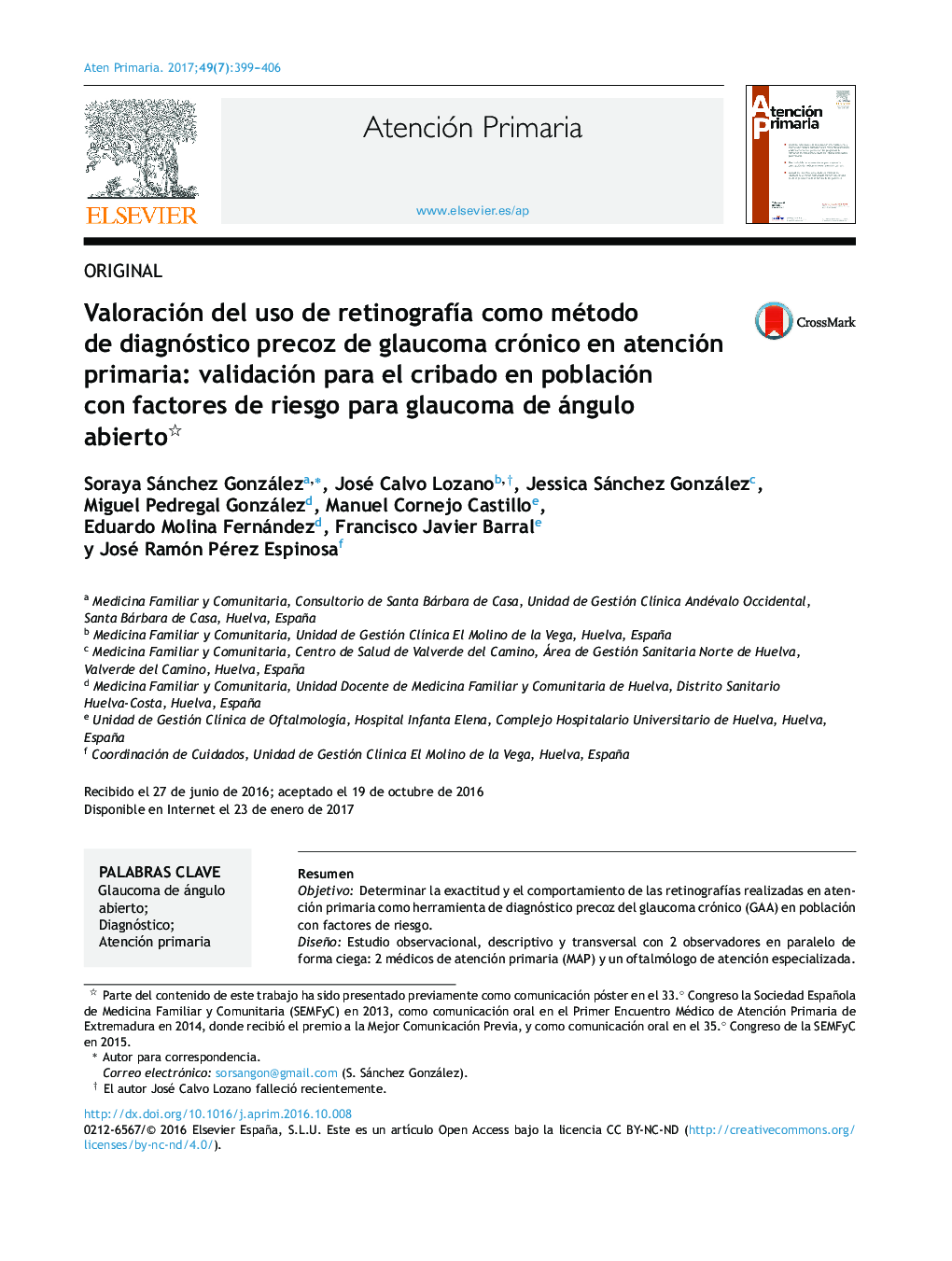| کد مقاله | کد نشریه | سال انتشار | مقاله انگلیسی | نسخه تمام متن |
|---|---|---|---|---|
| 5678047 | 1408567 | 2017 | 8 صفحه PDF | دانلود رایگان |

ResumenObjetivoDeterminar la exactitud y el comportamiento de las retinografÃas realizadas en atención primaria como herramienta de diagnóstico precoz del glaucoma crónico (GAA) en población con factores de riesgo.DiseñoEstudio observacional, descriptivo y transversal con 2 observadores en paralelo de forma ciega: 2 médicos de atención primaria (MAP) y un oftalmólogo de atención especializada.EmplazamientoCentro de atención primaria urbano, consultas externas del servicio de oftalmologÃa (hospitalario).ParticipantesCiento noventa y seis pacientes de ambos sexos, entre 40-70Â años, diabéticos, hipertensos, no diagnosticados de glaucoma, captados mediante llamada telefónica tras revisión de listados de pacientes. Dos de los pacientes no acudieron a las citaciones para las pruebas oftalmológicas, considerándose como pérdidas.MedicionesPara la variable cuantitativa diagnóstico de glaucoma por retinografÃa: exactitud calculada por la sensibilidad y especificidad, comportamiento por los valores predictivos positivo y negativo, cociente de probabilidad positivo y negativo, concordancia interobservador por Ãndices kappa y cociente de correlación intraclase (CCI).ResultadosSe obtuvo una sensibilidad del 21% (ICÂ 95%: 0-43%), especificidad del 93% (ICÂ 95%: 89-97%), valor predictivo negativo del 94% (ICÂ 95%: 90-97%) y positivo del 20% (ICÂ 95%: 0-40%); cociente de probabilidad positivo de 3,07 (ICÂ 95%: 0,98-9,62) y negativo de 0,84 (ICÂ 95%: 0,64-1,11). El CCI fue de 0,653 (ICÂ 95%: 0,495-0,769), y el Ãndice kappa, de 0,140 (ET: 0,106).ConclusionesLa retinografÃa no presenta un comportamiento adecuado como herramienta de diagnóstico precoz de GAA desde atención primaria según el modelo planteado en nuestro estudio. SerÃan necesarios ajustes que subsanasen su baja sensibilidad, como usar otras pruebas combinadas y mejorar el entrenamiento de los MAP.
ObjectiveThe aim of this study is to determine usefulness, validity of retinographies performed in Primary Care as a tool for early diagnosis of open-angle chronic glaucoma (OAG).DesignAn observational, descriptive and cross-sectional study with two blinded parallel observers: 2 general practitioners and 1 ophthalmologist.LocationUrban Primary Care Health Centre, and the Ophthalmology Department outpatient clinic.ParticipantsA total of 196 patients of both genders, between 40-70Â years, with diabetes and hypertension, and undiagnosed with glaucoma, were recruited by phone call after checking patient lists. Two patients that did not arrive for their appointments for the ophthalmology tests were considered as losses.MeasurementsFor the quantitative diagnostic variable of glaucoma: Accuracy calculated from the sensitivity and specificity, safety from the positive and negative predictive values and the positive and negative probability ratio; interobserver concordance by Kappa index ratio and the intraclass correlation (IC).ResultsThe retinography for OAG screening has a sensitivity of 21% (95%Â CI: 0-43%), a specificity of 93% (95%Â CI: 89-97%), a negative predictive value of 94% (95%Â CI: 90-97%), and positive of 20% (95%Â CI: 0-40%); positive probability ratio of 3.07 (95%Â CI: 0.98-9.62) and negative 0.84 (95%Â CI: 0.64-1.11). The IC was 0.653 (95%Â CI: 0.495-0.769) and kappa index of 0.140 (0.106Â ET).ConclusionsAccording to this proposed model, retinography is not a useful tool for the early diagnosis of OAG in Primary Care, as it is not safe enough. Before it can be used, it would need adjustments for its low sensitivity, and the use other combined tests. The training of general practitioners would also need to be improved.
Journal: Atención Primaria - Available online 23 January 2017